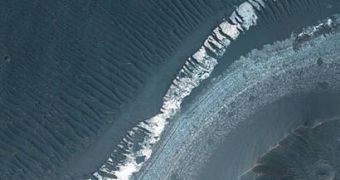It's no secret now, Mars is thought to have been much hotter in its past, basically meaning that it could also have had liquid water on its surface at some point in time. NASA's Mars Reconnaissance Orbiter and ESA's Mars Express routinely return evidence of what seems to be gullies or lake beds possibly created by the erosive action of water. The HiRISE camera equipping the Mars Reconnaissance Orbiter reveals new images of a crater which one day might have been filled with water or could have even housed life.
The crater featuring in the images is Holden Crater, which shows what seems to be a debris-strew consisting of a mix of broken boulders and rock fragments, generally known as megabreccia. Both types of debris are well known to contain mineral deposits that could only form within a liquid water environment, signaling the possibility of the past existence of habitable environments on the surface of the Red Planet. Unfortunately, NASA researchers cannot study in detail the region around Holder Crater, as none of the two twin rovers, Spirit and Opportunity, are anywhere near it.
They will just have to wait until the Mars Science Laboratory will arrive on the surface of Mars, but even then the possibility of studying it remains rather remote, mostly because the MSL mission did not yet chose the landing spot. The Holden Crater has to compete with another 5 designated locations for the title of landing site.
According to NASA, the Holden Crater formed inside a second impact basin, when rocks as large as 50 meters in diameter could have been thrown into the Martian atmosphere, only to form a megabreccia layer on impact with the surface. Sediments were set on top of the megabreccia layer, possibly by water, and might have even formed clays that could hold evidence of the past existence of life.
At one point in time, part of the rim forming the Holden Crater collapsed releasing the energy of nearly 4,000 cubic kilometer of water in the process, thus revealing the clay layers. Scientists approximate that Holden Crater could have contained water as long as a few thousand years, before a new lake formed in the outcome of the crumbled rim, lasting only a few hundred years.

 14 DAY TRIAL //
14 DAY TRIAL //